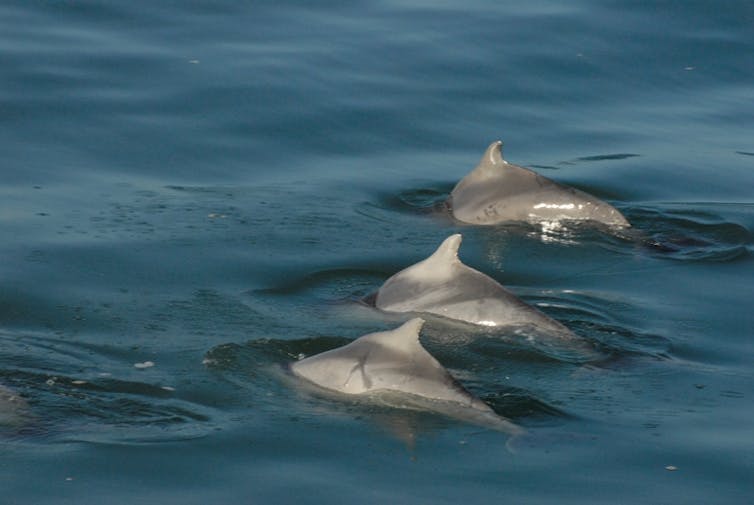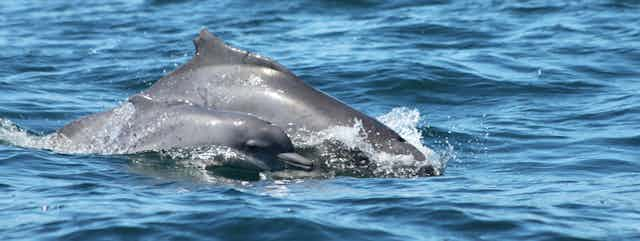When discussing my research on humpback dolphins people often think I mean the humpback whale. The humpback dolphin is probably the least-known marine mammal of Africa. It lives close to shore, just behind the breakers in waters up to about 20m deep. Humpback dolphins are very shy. They regularly swim in small groups and, as a result, they are not easy to spot.
Various other species of dolphin can be found along the coast of east Africa, including the Indo-Pacific bottlenose dolphin (Tursiops aduncus), the common dolphin (Delphinus delphis/capensis) and the spinner dolphin (Stenella longirostris). But the humpback dolphin is different in one key respect. It prefers to live close to shore, making it highly vulnerable to human coastal activities.
There are fewer than 1,000 Indian Ocean humpback dolphins left off South Africa’s coast. This makes it one of south and east Africa’s most endangered marine mammals. Research on how fast this species has declined in the past decade is still ongoing.
Less abundant than previously thought
Until quite recently humpback dolphins on the east coast of Africa were believed to belong to the species Sousa chinensis, a species of humpback dolphin that ranged all the way to China and down to Australia. But recent genetic studies have divided the humpback dolphin in that range into three different species.
The Indian Ocean humpback dolphin (Sousa plumbea) ranges between South Africa and India. The humpback dolphins on the South African coast can be divided into two further sub-populations: one occurring between False Bay up to Algoa Bay; and another on the KwaZulu-Natal coast. There are slight genetic differences between these two populations, suggesting that there is no or very little reproduction between them. In addition, the geographical gap between the populations might make reproduction between them impossible.
The Indo-Pacific humpback dolphin (Sousa chinensis) ranges from India to China.
The Australian humpback dolphin (Sousa sahulensis) occurs in Australia.
The fact that humpback dolphins belong to three different species has major conservation implications. It shows that population sizes are less abundant then previously believed.
More susceptible to humans
Typically, these dolphins have a preference for reef areas and usually feed on the fish species common in these habitats, like mullet. Unfortunately, their dependence on specific coastal habitats is one of the things that makes them susceptible to the impact humans have on the ocean. Man-made problems like overfishing, pollution and habitat degradation, and shark-nets affect the species enormously, leading to population declines.
Between 1980 and 2009, 203 humpback dolphins died in the shark nets off KwaZulu-Natal.

The Indian Ocean humpback dolphin is listed by the International Union for Conservation of Nature as vulnerable. The total population is estimated to be 10,000. This is very low compared with, for example, the population size of the long-beaked common dolphin (Delphinus capensis), which ranges into the hundreds of thousands.
The International Union for Conservation of Nature is revising the status of the Indian Ocean humpback dolphin and is expected to list it as endangered soon. In South Africa it is already listed as endangered.
The future for humpback dolphins, particularly South Africa’s Indian Ocean humpback dolphin, does not look promising.
But there are efforts to protect it. The continuous population decline has prompted a collaboration between Sea Search, a collective of marine mammal biologists, and the University of Pretoria to set up the SouSA project. The aim is to improve the understanding of the species’ total population abundance, population dynamics and ecological needs.
Additionally, the goal of the SouSA project is to set up a national collaboration with various other research groups to work towards forming a cohesive picture of the species. At the same time, the Wildlife Conservation Society is researching the species in Mozambique and Tanzania. The hope is that one day we will be able to unite all our efforts and conduct research on the species across countries.

